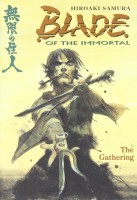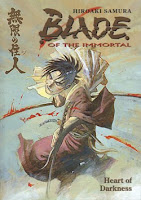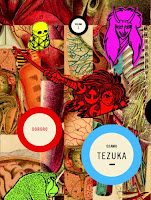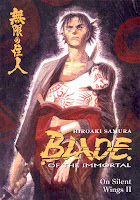 Creator: Hiroaki Samura
Creator: Hiroaki Samura
U.S. publisher: Dark Horse
ISBN: 9781569715468
Released: August 2001
Original release: 1997-1998
Awards: Eisner Award, Japan Media Arts Award
The Gathering is the eighth volume of the English edition of Hiroaki Samura’s award-winning manga series Blade of the Immortal. Published in 2001 by Dark Horse Comics, The Gathering is most closely equivalent to the seventh volume of the Japanese edition of the series, published in 1997, although it also includes a chapter from the eighth volume which was first released in 1998. Blade of the Immortal has been the recipient of both an Eisner Award and a Japan Media Arts Award. Critically acclaimed in both the East and the West, the series is also one of my personal favorites. The Gathering marks the approach of the end of the second major story arc in Blade of the Immortal. The volume picks up almost immediately after the events in the previous volume, Heart of Darkness. Since there were some pretty major developments in that volume, I was particularly looking forward to reading The Gathering.
After their violent falling out with Shira, Manji and Rin’s tenuous alliance with the Mugai-ryū assassins dissolves. Anotsu has successfully left Edo without being caught and is now well on his way to Kaga and out of the Mugai-ryū’s reach. They do, however, have an idea where Anotsu is heading. But they’re not about to tell Manji without getting something in return. Rin, still determined to pursue Anotsu, realizes that she is the only one who even has a chance of passing through one of Edo’s checkpoints and leaves Manji behind without telling him where she is going. It doesn’t take much for him to figure it out and Manji is ready to do anything it takes to follow her. But to complicate matters further, both Rin and Manji are now wanted for murder. It will be extremely difficult for either of them to leave Edo, let alone find Anotsu.
Rin is no longer as naive as she once was, although this doesn’t stop her from making decisions she knows are foolish. She has seen some terrible things on her path of revenge against Anotsu and it has changed her. The journey has changed Manji as well. He has become more open in showing his concern for Rin. While he has become quite attached to the younger girl and is very protective of her, he is not overprotective. But as soon as she disappears Manji doesn’t hesitate for a moment to try to find her again. It’s been a while since Manji has really let loose in a fight (it’s also been quite some time since he’s really needed to) but he is given ample opportunity to in The Gathering. He is at a distinct advantage because of his near immortality, but this also means he has a lot more pain and suffering in store for him. Still, Manji is able to employ in very dramatic and effective ways techniques and strategies that other swordsmen would only resort to out of desperation (if at all).
While Rin and Manji are attempting to leave Edo, the members of the Mugai-ryū are trying to make the best out of the situation. Manji and the Mugai-ryū may no longer be allies but they are all ready to use one another for their own benefit. Although the assassains’ backgrounds are still mostly a mystery, The Gathering reveals a few more hints about their employers. The assassins may be ruthless and violent, but at least for the moment it’s in their interest that Manji and Rin are alive. On the other hand the Ittō-ryū—Anotsu’s sword school—is itching to take down the man who has single-handedly killed so many of their own. Anotsu has already proven himself to be a formidable opponent, but many of the other members of the Ittō-ryū are crafty and skilled fighters, too. Even if they don’t particularly get along, Manji has given them a common goal for the time being. The Ittō-ryū is most definitely made up of the individuals with their own ways of doing things. The Gathering leaves off in the middle of an intense fight and I’m looking forward to seeing how it concludes in The Gathering, Part II.




